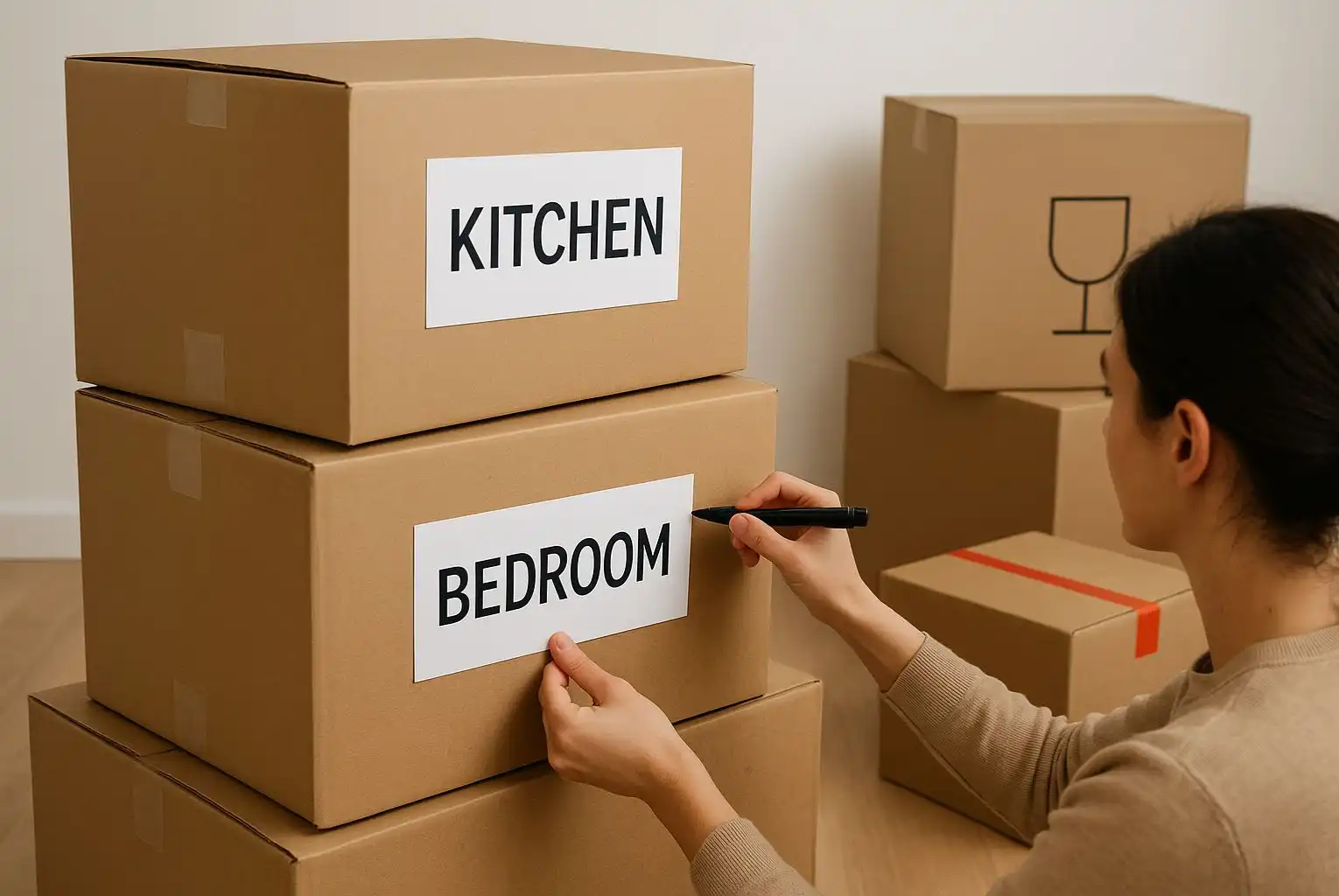THE ESSENTIAL DOS AND DON’TS OF LABELLING MOVING BOXES FOR A SMOOTH RELOCATION

Introduction
When it comes to planning a move, one often overlooked yet crucial step is labelling moving boxes. While packing your belongings safely is important, how you label them determines how efficiently they can be transported, unpacked, and organized in your new home. Many people underestimate the role proper labelling plays in ensuring a stress-free move—but it can save you hours of frustration, misplaced items, and even accidental damage.
In this thorough guide, we'll guide you through the dos and don’ts of labelling your boxes, what to avoid, and the best ways to ensure that your next move is smooth. If you're planning to move on your own or working with packers and movers, these tips will provide you with confidence and clarity.
Why Is Labelling Moving Boxes So Important?
Imagine entering your new residence and being surrounded by 30 identical brown containers without knowing which one contains your bedding sheets, as well as utensils and bathroom items. Frustrating, right? That's the reason knowing the proper way to mark moving containers is crucial. It will allow you to:
- Identify contents quickly, without opening many cartons.
- Send boxes to the right rooms as soon as possible.
- Be aware of items that are fragile and require special attention.
- Avoid stress during unpacking.
If done properly, labeling your belongings ensures that your move isn't just about moving items, but also about organizing your new home efficiently, starting from the beginning.
Do: Be Specific About What's Inside
One of the best practices when using moving box labels is to use descriptive labels. Instead of labeling the box "kitchen," note what's inside the box, such as "kitchen - plates and cups." This will help avoid confusion later when searching for something specific.
Being specific also assists the moving company to place the boxes in the right order and helps you prioritize the process of unpacking. For instance, boxes that are marked "bedroom - nightstand essentials" must be first opened; the boxes marked "winter clothes" can wait.
Don’t: Overcomplicate with Excessive Details
Although details are important, do not turn your cardboard boxes into long lists of items. Recording each item could be too much and unnecessary. Instead, you should balance the detail by limiting it to categories that are concise and the main content.
A packing guide will help simplify the process, making sure that labelling is useful instead of burdensome.
Do: Use a Color-Coding System
A smart method to simplify the entire process of moving is the color-coding of packing boxes. Give each room a distinct hue, such as blue for kitchens, red for bedrooms, and green for the living room.
Make use of colored tape, markers, or labels that are pre-printed to make the system simple to follow. This will not only speed up the process of unloading but also make unpacking easier, as the movers will be able to quickly determine which boxes belong to which.
Don’t: Forget to Mark Fragile Items
One of the golden rules of the dos and don'ts of labeling moving boxes is remembering to mark fragile items clearly. Make use of bold, large letters or stickers that read "FRAGILE - Handle with Care."
The proper labeling of fragile boxes will ensure that movers are giving them the care they deserve, which reduces the chance of breaking. Adding an arrow and "This Side Up" symbols can also help protect your valuable belongings.
Do: Number Your Boxes for Better Tracking
A movable box numbering method is a second professional suggestion that makes tracking simpler. Put a number on each box (for instance, Box 1 of 20, Box 2 of 20) and then keep an organized list of what each box contains.
This method is useful in situations when you need to confirm that all boxes arrived safely at your new location, preventing losses or misplaced cartons.
Don’t: Use Illegible or Faint Markers
One mistake that people often make is using dull pens or markers that fade in transit. This can make it difficult to see boxes when they're being stacked. Make sure to use permanent markers with bright colors, such as black or red, to make sure they are visible.
Clear, bold writing is the best way to label moving boxes— easy to understand, weather-proof, and easy for the movers to find.
Do: Write Labels on Multiple Sides
If you’re wondering what to write on moving boxes, placement matters just as much as content. Do not just write at the bottom of your box; ensure that you mark at least two sides adjacent to each other.
This will ensure that, regardless of how the boxes are placed, the label is always clearly visible. This saves time for moving and helps you unpack.
Don’t: Delay Labelling Until the End
A lot of people rush to pack and believe they'll label the boxes later. But when the last box is sealed, the fatigue begins to set in, and labels are omitted. To prevent this, make sure to label each box immediately after sealing it.
Following this habit is one of the easiest but most efficient methods of moving you can apply.
Do: Keep Essentials Separate and Clearly Labelled
Every move needs an “essentials” box. This can include toiletries, chargers, medications, documents, and a change of clothes. Label the box with "Open First" or "Essentials" to allow you access to it quickly without having to go through every carton.
This technique is extremely helpful in figuring out the best way to work out how to arrange your moving boxes and allows you to prioritize unpacking according to urgency.
Don’t: Rely Solely on Labels
Labels are essential, but do not rely solely on labels. Make use of strong tape, double-wrap fragile objects, and pack them carefully. Knowing how to pack moving boxes is as crucial as labeling them properly. Unpacking poorly can result in destruction, even with the top labels.
For assurance, think about hiring professionals who are experts in the packing process. They provide efficiency, knowledge, and appropriate tools to guarantee a smooth experience.
Final Thoughts
Understanding the dos and don’ts of labelling moving boxes can be the difference between chaos and peace during the process of moving. From being specific with contents, using color codes, numbering boxes, and marking fragile items, to avoiding blunders such as faint labels or skipping details, these methods help ensure a smooth transition.
Keep in mind that the secret lies not only in packing, but also in clear communication via labels. If done correctly, it will result in an easier setup in your new residence and lessen the stress associated with moving.
If you're in search of an expert partner to help you make your move easier with professional packing, labelling, transportation, and packaging, PM Relocations is here to assist. With decades of experience and a comprehensive array of move-in services, PMR ensures that each step is efficient, organized, and easy.
Our Blogs

BEST SCHOOLS IN DELHI: YOUR COMPLETE GUIDE TO THE BEST 10
Finding the right school is one of the most important decisions for parents, especially when moving to a new city like Delhi. With a wide range of CBSE, ICSE, IB, and international schools, the capital offers excellent educational opportunities—but choosing the best one can feel overwhelming. This comprehensive guide to the best 10 schools in Delhi breaks down key factors such as academic excellence, teaching standards, campus facilities, extracurricular activities, and overall student development. Whether you are a local resident or relocating to Delhi, this blog will help you compare top schools and make a confident, well-informed choice for your child’s future.

MOVING TO SPAIN FROM INDIA: BEYOND BEACHES AND INTO A NEW WAY OF LIFE
Moving to Spain from India is not just a change of location—it’s a complete shift in lifestyle, culture, and everyday living. Beyond the famous beaches and vibrant festivals, Spain offers a slower pace of life, a strong work-life balance, and rich traditions that shape daily experiences. From understanding visa requirements and housing options to adapting to Spanish work culture, food habits, and social life, this guide helps Indians prepare for a smooth and confident transition into a new way of life in Spain.

RELOCATING TO NORWAY: NAVIGATING THE COLD-CHAIN CHALLENGE
While most expats worry about visas and housing, many overlook Norway’s most formidable resident: the climate. Navigating the "cold-chain" is the secret to a successful move. From preventing electronics from cracking in sub-zero transit to ensuring your heirloom wooden furniture survives the shift in humidity, mastering the logistics of temperature-sensitive transport is essential for anyone heading North.



